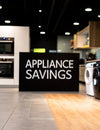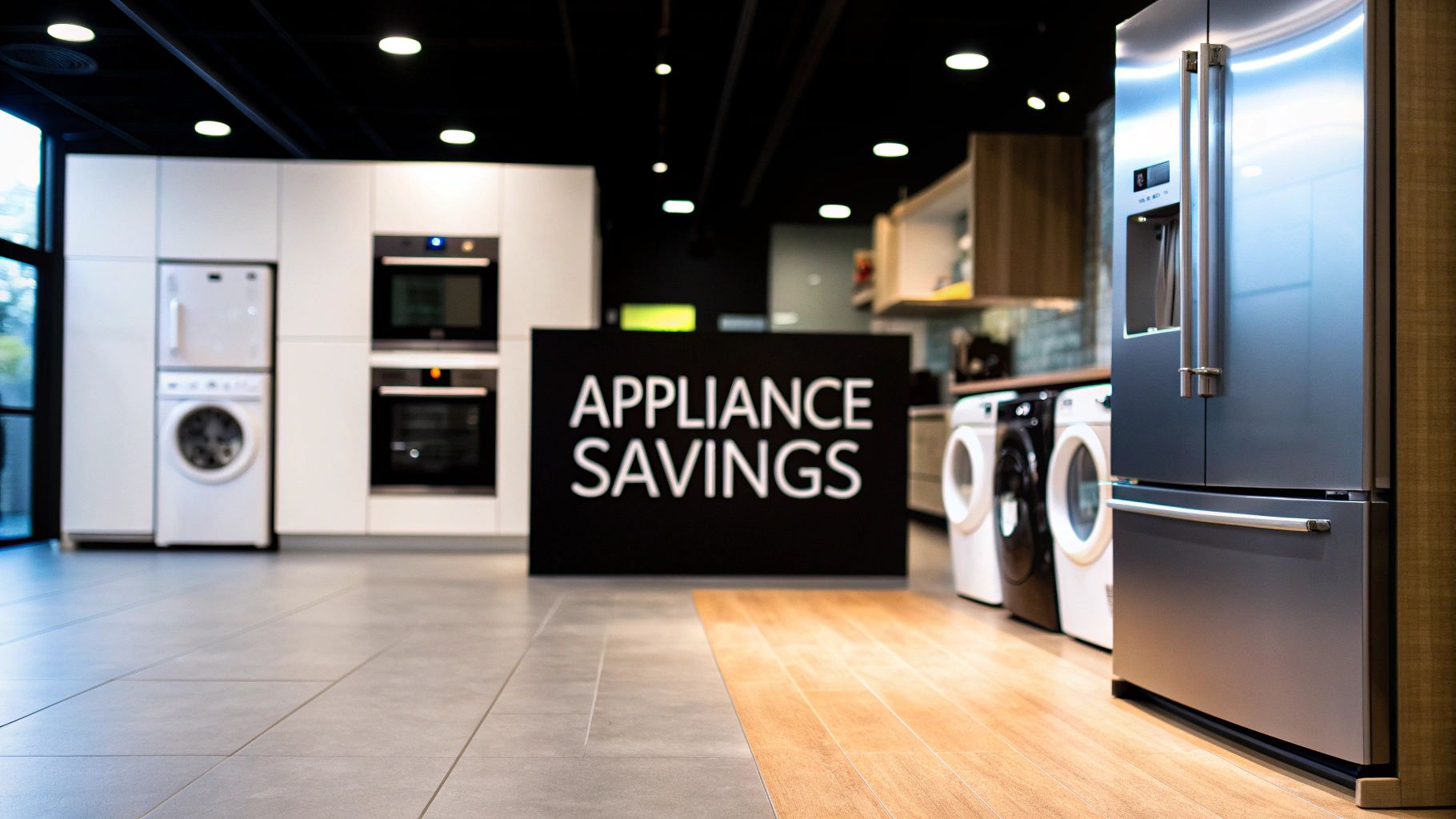
If you’ve ever had an appliance die unexpectedly, you know the panic of having to buy a replacement right now. But if you can plan ahead, you can save a serious amount of cash by timing your purchase just right.
The secret isn’t complicated: retailers run on a predictable cycle. They have to clear out last year’s models to make room for the new ones, and they use major holidays to drive sales. This creates perfect windows of opportunity for anyone looking to score a deal. The best times to buy are typically during major holiday weekends, in the fall from September to December as new models roll in, and even at the end of the month when stores are trying to hit their sales quotas.
Your Annual Appliance Buying Calendar
Think of the appliance market like the fashion industry. Every year, new styles and features are released, which means the "last season" models—which are still brand new and perfectly functional—get marked down for clearance. If you know when these sales happen, you can strategically plan your purchase and avoid paying full price.
This calendar is your roadmap to those savings, highlighting the key moments throughout the year when you'll find the best deals.
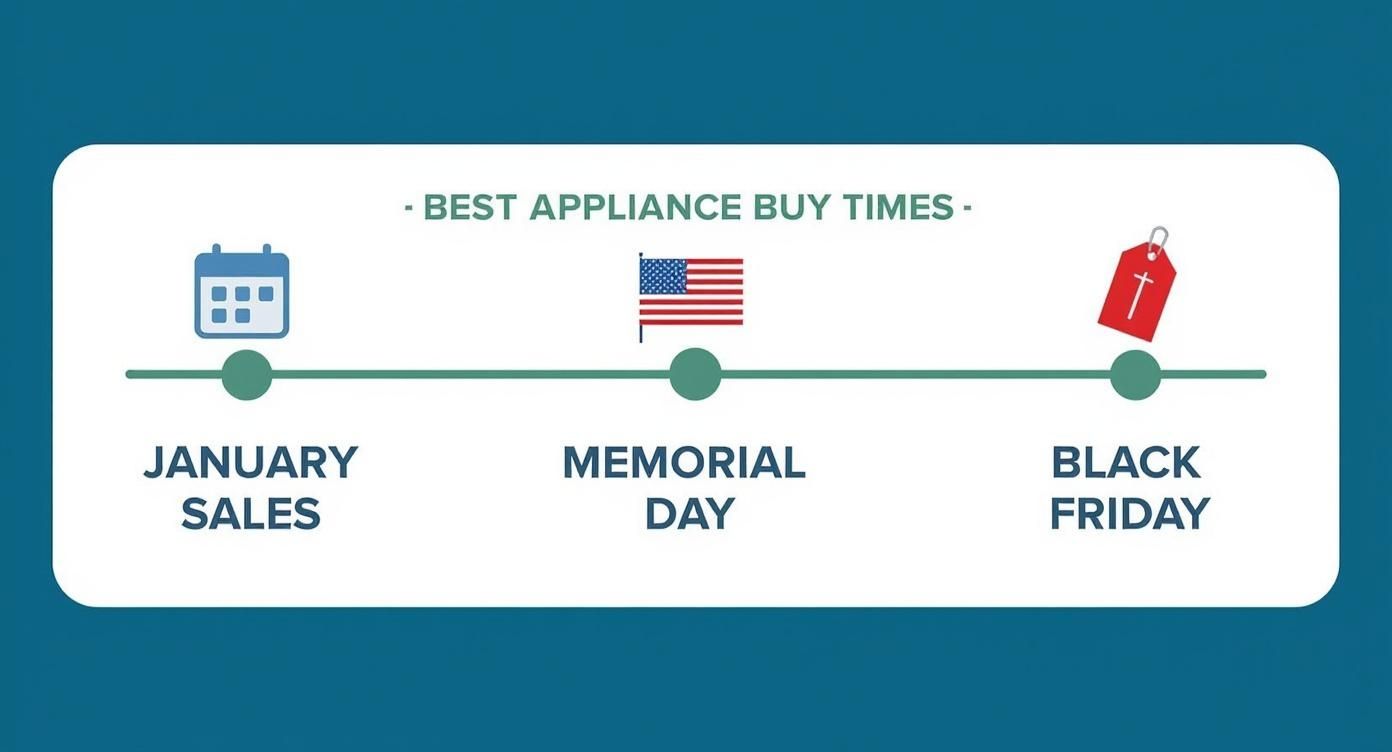
As you can see, opportunities pop up all year long, but they really spike around holidays like Memorial Day and, of course, Black Friday. Let's break it down even further.
Your Annual Appliance Buying Calendar
This table lays out the entire year, so you know exactly what to look for and when. It details which appliances typically go on sale during specific holidays, the kind of discounts you can realistically expect, and why it's a smart time to buy.
| Time of Year / Holiday | Best Appliances to Buy | Typical Discount Range | Why It's a Good Time |
|---|---|---|---|
| January/February | Refrigerators, Ovens, Ranges | 15-35% | Retailers clear out last year's models to make space for new inventory. |
| Memorial Day (May) | Refrigerators, Washers/Dryers | 20-40% | One of the biggest appliance sales of the year, often with bundle deals. |
| July 4th | All Major Appliances | 15-30% | Mid-year sales event with competitive pricing across all categories. |
| Labor Day (September) | All Major Appliances | 20-40% | Kicks off the fall clearance season as new models begin to arrive. |
| October/November | Dishwashers, Ranges | 25-50% | Black Friday pre-sales and new model clearance continue to drive down prices. |
| Black Friday/Cyber Monday | Small & Large Appliances | 30-50%+ | The biggest sale event of the year with doorbuster deals and deep discounts. |
The key takeaway here is that patience pays off. By waiting for one of these predictable sales, you can get a top-quality, brand-new appliance for a fraction of what you’d pay on any random Tuesday.
The biggest mistake is buying impulsively when an old unit breaks. If you can anticipate the need and plan your shopping around these discount windows, the savings are substantial.
To make sure you're getting the absolute best price, always compare prices online to save more with expert tips. A little extra research ensures a "sale" price is a genuine bargain.
Cracking the Code of the Annual Appliance Sales Cycle
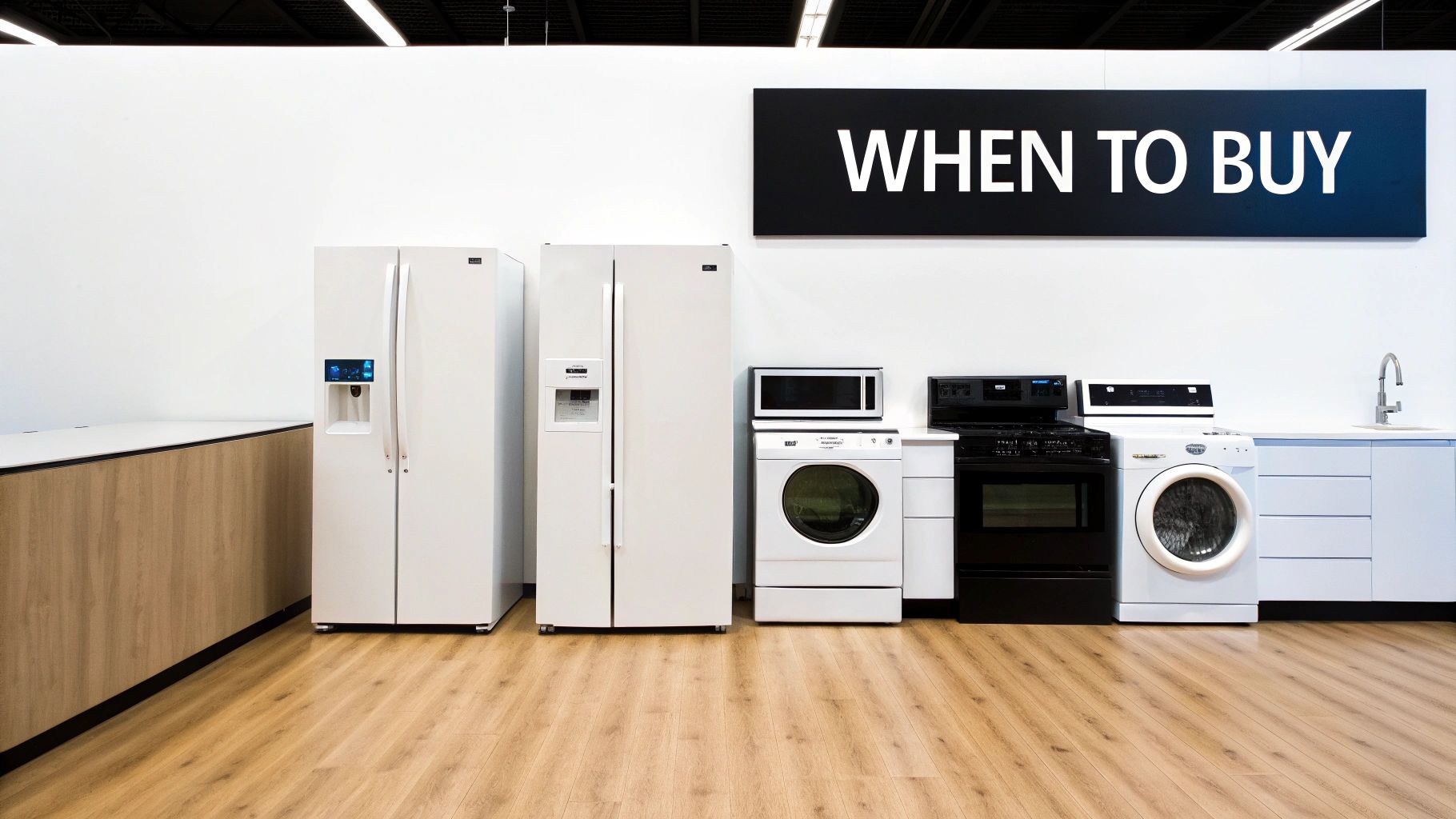
If you've ever wondered if there's a "right" time to buy a new appliance, the answer is a resounding yes. The appliance market moves in a surprisingly predictable rhythm, driven by one simple fact: retailers need to clear out old inventory to make room for shiny new models.
This cycle is your golden ticket. Think of it like a farmer clearing the fields for a new crop. Each year, manufacturers roll out their latest innovations, and stores have to move last year's models—fast. For a savvy shopper, this is where the real opportunities are.
Most major appliance brands, especially for big-ticket items like refrigerators, ranges, and laundry pairs, unveil their new lineups in the fall. To clear the showroom floor, retailers start slashing prices on the outgoing models. These appliances are still brand-new and packed with great features; they just aren't the absolute latest release.
Riding the Wave of New Model Rollouts
The easiest way to understand this is to think about the car industry. As soon as the 2025 models hit the dealership, the 2024s that are still on the lot get a major price cut. It’s the exact same game with appliances.
This changeover period is the absolute sweet spot. The best months to pounce are generally September, October, and January. In that window, you can snag last year's top-tier appliances for the price of a mid-range model.
For example, a high-end French door refrigerator might get a 20-35% price drop just because the newest version has a slightly updated ice maker or a different smart-home integration. This same principle is a big factor in finding the best time to buy electronics, where last year’s tech is still fantastic but much more affordable.
Key Takeaway: The "new year" for large appliances really kicks off in the fall. If you time your shopping for the September-to-January changeover, you can get a brand-new, perfectly good appliance at a steep clearance discount.
How Holidays Pour Fuel on the Fire
Retailers are smart. They know this new-model cycle is happening, so they magnify it by aligning their biggest sales events with major holidays. This creates a perfect storm for deal-hunters.
Black Friday and Cyber Monday are the most obvious examples. Retailers use the November shopping frenzy to accelerate their clearance efforts, often dropping prices by 20-40% on appliances. These promotions are timed perfectly with the arrival of new stock, making it a win-win for both you and the store.
By keeping these two forces in mind—the manufacturer's release schedule and the retailer's holiday promotions—you can stop reacting to a broken-down appliance and start planning your purchase. Timing is everything, and knowing the calendar can save you hundreds, if not thousands, of dollars.
Navigating Major Holiday Sales Events
While the fall model changeover offers a consistent drip of good deals, major holiday weekends are when the real floodgates open. Retailers use these long weekends to unleash aggressive, store-wide promotions, turning them into a fantastic time to buy—if you know how to play the game. Think of it like this: each holiday sale is a different kind of race, and you need the right strategy for each one.
It’s a common mistake to think all holiday sales are the same. They’re not. To really understand when to buy, you have to get a feel for the unique personality of each event. Some are marathons with steady discounts, while others are all-out sprints for doorbuster deals that vanish in minutes.
Black Friday vs. Three-Day Weekend Sales
When people think of sales, they almost always think of Black Friday. It's famous for a reason: the deals are often jaw-droppingly deep. Retailers roll out "doorbuster" prices on specific models to get shoppers hyped and into the store or onto their site. We're talking discounts that can hit 50% or more, but the catch is that inventory is usually razor-thin, and the competition is intense.
On the other hand, long holiday weekends like Memorial Day, the Fourth of July, and Labor Day present a completely different kind of opportunity. These sales aren't typically built around a few specific, high-drama deals. Instead, they feature broader discounts across entire categories.
These three-day events are less about frantic clicking and more about strategic planning. You'll find solid discounts of 20-40% across a wide range of brands and models, giving you more time to compare and choose the right appliance without the intense pressure of a Black Friday countdown.
This makes them a perfect time for anyone tackling a full kitchen remodel or needing to outfit a home with multiple appliances at once. The bundle deals are often the main attraction.
Your Holiday Shopping Playbook
Showing up on the day of the sale and hoping for the best is a recipe for overspending. To really make these events work for you, a little prep work is essential. This is how you can be sure a "sale" price is actually a great deal.
Here’s a simple game plan that works every time:
- Research Models Early: Start looking a month or two before a big sale. Figure out the features you absolutely need and create a shortlist of 2-3 models from different brands. Jot down their model numbers and what they're selling for right now.
- Track Price History: I can't stress this enough. Use a price-tracking website or a browser extension to see how the price of your shortlisted appliances has fluctuated over time. This is the only way to know if that "40% off" sticker is based on a genuinely low price or an inflated MSRP.
- Set Up Alerts: Get on the email lists for the big retailers. It's the inside track to getting early access to sales flyers and notifications when the specific models you're watching go on a lightning deal.
By lining up what you need with the right type of holiday sale and doing your homework, you can walk into the chaos with a clear plan. It transforms a potentially overwhelming experience into a calculated move to get exactly what you want at the lowest possible price.
Hidden Seasonal and Clearance Opportunities

While the big holiday sales get all the hype, some of the absolute best deals are hiding in plain sight. If you know where to look, you can often beat those Black Friday prices without fighting the crowds. It's all about understanding the retailer's mindset and a little bit of seasonal logic.
Think of it like buying a winter coat in March. Stores are practically giving them away because they need to make room for swimsuits. The exact same principle applies to appliances, creating predictable windows for savvy shoppers to score a bargain.
Timing Your Purchase with the Seasons
For certain appliances, the rule is simple: buy when everyone else isn't. Retailers hate storing bulky, seasonal inventory that won't sell for another eight months, and they’ll slash prices to get it off the floor. This is your cue to swoop in.
Here’s a quick breakdown of how this plays out:
- Air Conditioners: The best time to buy an AC unit is from September to November. The last thing on anyone's mind is a heat wave, so demand is at rock bottom. That’s when you’ll see prices drop.
- Heaters and Fireplaces: On the flip side, start shopping for these in late spring and early summer. As the weather warms up, stores get desperate to clear out their remaining cold-weather stock.
The secret is to zig when everyone else zags. Buying seasonal items when demand is lowest can easily save you 25-40%—often more than you'd save during a major holiday sale.
A great way to stay on top of these cycles without constantly checking prices is to set up price drop alerts for the models you have your eye on.
Unlocking Savings with Floor Models and Scratch-and-Dent Deals
Here's another trick I always recommend: ask about floor models, open-box returns, or "scratch-and-dent" units. These are brand-new appliances that are perfectly functional but have a minor cosmetic flaw—maybe a small scuff on the side or a ding on a corner that will be hidden by your cabinets anyway.
Because they can't be sold as "pristine," retailers knock the price down significantly. We're talking an extra 10-20% off the already-discounted price.
Just be sure to do two things. First, inspect the damage yourself to make sure it's purely cosmetic. Second, confirm that it still comes with the full manufacturer's warranty (it almost always does). A tiny, invisible scratch can mean hundreds of dollars back in your pocket.
How Global Trends and Technology Influence Pricing
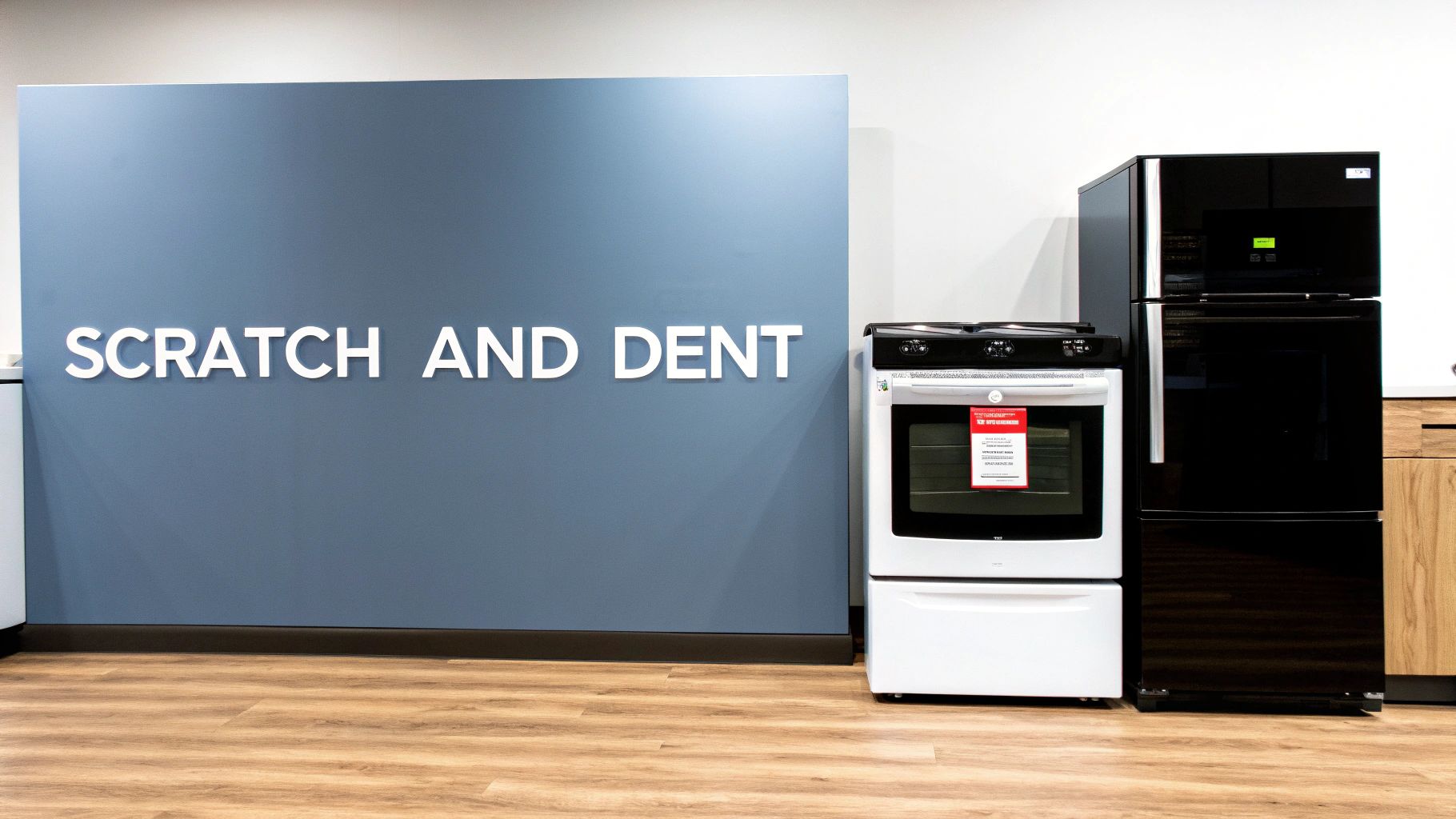
It’s easy to get caught up in the rhythm of holiday sales, but some of the biggest influences on appliance prices happen far from the showroom floor. Huge, global forces—from manufacturing costs to the constant drumbeat of new technology—are always at play, creating shifts in what you'll pay. If you learn to spot these trends, you can look past the flashy sale signs and make a much smarter buy.
Think of it this way: appliance pricing isn't just about what a local store decides. A spike in the cost of steel on the other side of the world can nudge up the price of that refrigerator you've been eyeing. Similarly, a major disruption in overseas shipping can cause inventory headaches and inflate the cost of popular models. It’s all connected.
On the flip side, technology is your secret weapon for savings. As soon as a manufacturer rolls out a new smart oven with some gee-whiz feature, the model it replaced suddenly seems a little less special. This cycle of innovation is relentless, and it means fantastic, slightly older tech can often be had for a steal.
The Impact of Smart Home Integration
The whole “Internet of Things” (IoT) movement has completely reshaped the appliance world. It’s no longer just about washing clothes or keeping food cold. Top-tier appliances now link to your Wi-Fi, chat with your smartphone, and can even tell a technician what’s wrong before they arrive. This push for connectivity is a huge reason the global home appliance market keeps growing.
People are more willing than ever to ditch a perfectly functional older appliance for a new one loaded with smart features. In North America, this trend accounts for a market share of about 32.5%, with much of that demand focused on connected, energy-saving models.
Here's the bottom line: when a new "must-have" feature hits the market—like an oven with a built-in air fryer—the previous generation instantly loses some of its shine. That's your cue to swoop in and find a bargain.
Watching for Energy Efficiency and Rebates
Another major factor is the massive push for better energy efficiency. With stricter environmental standards, companies are racing to create appliances that use way less power and water. This is great for the planet, of course, but it's also a direct win for your wallet every month when the utility bills arrive.
Beyond the sticker price, these efficiency gains offer serious long-term value. For example, looking into Energy Star certified HVAC systems can uncover hidden savings on heating and cooling costs. Plus, keep an eye out for rebates from governments and utility companies. They often offer cash back for buying high-efficiency models, giving you another way to stack your savings.
What Happens When Unexpected Events Wreck the Shopping Calendar?
While we can count on holiday sales and new model releases like clockwork, sometimes life throws a wrench in the works. Things like global pandemics or massive economic shifts can completely scramble the predictable rhythm of appliance sales. When that happens, knowing how to pivot is far more important than just waiting for the next big sale.
These disruptions create a powerful ripple effect that can be felt from the factory floor to your local showroom. A sudden manufacturing halt on the other side of the world can dry up the supply of a critical part, stalling production for months. At the same time, shipping bottlenecks can leave containers full of brand-new appliances sitting in a port, leading to empty shelves right when your refrigerator decides to give up.
A Real-World Example: The Pandemic Effect
The COVID-19 pandemic was a masterclass in market disruption. With everyone stuck at home, there was a huge surge in home improvement projects. All of a sudden, people were desperate for a new chest freezer for stockpiling, a better oven for their newfound sourdough hobby, or a more reliable washing machine to handle the extra laundry.
This sudden spike in demand slammed head-on into a wall of supply chain chaos. The perfect storm of component shortages, labor issues, and logistical nightmares in 2020 and 2021 meant fewer appliances were making it to stores just as everyone wanted one. Naturally, prices went up and stock went down, making it nearly impossible to find a good deal, let alone the exact model you were looking for. You can find more data on these major market shifts at Grandview Research.
In unpredictable times, flexibility is your secret weapon. The "best" time to buy might evaporate, so you have to shift from a calendar-based strategy to one that's all about being nimble and opportunistic.
How to Shop Smart in an Unpredictable Market
When things are chaotic, clinging to your original plan can cost you. Instead, you need to stay flexible and adapt.
Here are a few practical ways to do that:
- Be brand-agnostic. If your first-choice brand is nowhere to be found or the price is sky-high, it's time to look at the competition. Be open to exploring comparable models from other well-regarded manufacturers.
- Think repair, not just replace. Is your current appliance truly on its last legs? It might be worth getting a repair quote. Fixing it could be a much smarter financial move than buying a new one at an inflated price during a shortage.
- Become an online stock-checker. Most big retailers have tools on their websites that show you real-time inventory at local stores. Use them! You can quickly see who has what you need in stock and avoid waiting weeks for a back-ordered item.
Answering Your Final Appliance-Buying Questions
Even with a solid strategy, a few nagging questions can pop up right before you pull the trigger. Let's clear up some of the most common concerns to make sure you're feeling completely confident in your decision.
Is It Better to Buy Appliances Online or In-Store?
This is the classic head-scratcher, but the truth is, you should probably do both. The internet is unbeatable for the initial legwork. You can compare specs and prices across dozens of models and read hundreds of real-world user reviews, all without a salesperson breathing down your neck.
But you can't get a feel for an appliance through a screen. A trip to a physical store is your only chance to open the doors, touch the controls, and see if that stainless steel finish is really fingerprint-resistant. This is also where the real horse-trading happens—you'll never find a deal on a floor model or a slightly scuffed open-box item sitting in an online shopping cart.
Here's the pro move: Do your homework online to create a shortlist of your top two or three contenders. Then, head to a showroom to get hands-on with them and ask about any unadvertised deals or floor model discounts.
Should I Get an Extended Warranty for My New Appliance?
Extended warranties are pitched as a must-have safety net, but more often than not, they’re an unnecessary expense. Remember, every new appliance already includes a manufacturer's warranty, which typically covers parts and labor for the first year. For a well-built machine, the odds are in your favor that nothing major will go wrong in years two or three.
Before you even consider paying for extra coverage, check your credit card perks. Many cards automatically double the manufacturer's warranty for free, giving you a second year of protection without costing a dime. A warranty might make sense for a super-complex fridge with multiple circuit boards, but for a basic workhorse washer? You're probably better off just putting that money aside yourself.
Are Appliance Bundle Deals a Good Value?
Kitchen bundles can be really tempting. Buying a matching suite from a single brand often nets you a nice discount, usually knocking 10–20% off the total. If you're overhauling your entire kitchen and want that clean, cohesive look, this is definitely the easiest way to get it.
The downside? You’re locked into one brand for everything. You might be getting a rockstar refrigerator but have to settle for a mediocre dishwasher that came with it. When you're spending this much, you'll want to know which appliance brands are most reliable to avoid headaches later. Always do the math—price out each appliance you really want individually. Sometimes, the savings from a bundle aren't worth the compromise on quality or features.
At FindTopTrends, we curate the best deals on high-quality home essentials, helping you shop smarter and stay ahead of the curve. Discover trending products and insightful guides to make every purchase a confident one at https://findtoptrends.com.






